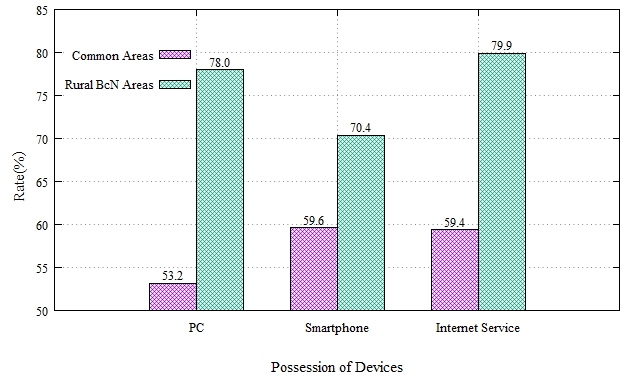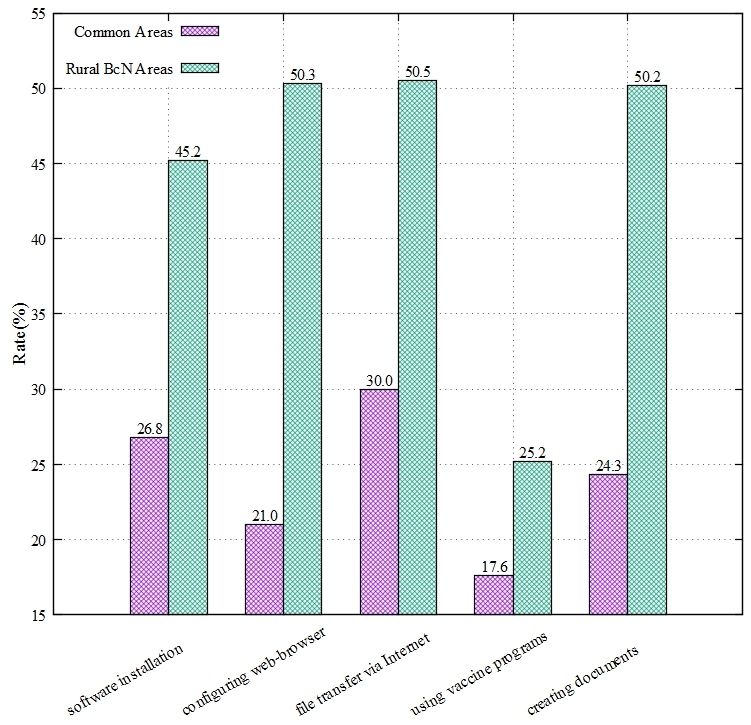
Analysis and Future Direction of Rural BcN Construction of Korea
Abstract
The recent progress of network technology has been taking an important role of building people's lives on top of the closely connected infrastructure, called Internet. Countries all over the world have defined the network infrastructure as an essential element of country wealth, and have been investing great effort in making their network infrastructure faster and more reliable. Korean government had conducted rural BcN projects from 2010 to 2017. Broadband network was constructed in rural areas where the residents were suffered from digital divide and information segregation. As well as the social and cultural achievement, the whole economic benefits are estimated as up to KW 160.45. In this paper, we delineate the purpose and the content of rural BcN projects of Korea, and analyze the result of the projects according to several factors such as user satisfaction or improvement score. We also propose the future direction of network policies against digital divide based on the analysis outcome.
초록
유·무선 네트워크 기술의 비약적인 발전으로 국민의 삶의 질은 긴밀하게 연결된 인터넷과 관련 서비스들에부터 많은 영향을 받고 있다. 이에 세계 각 국은 네트워크 인프라를 국력의 중요한 요소로 간주하고 자국의 네트워크 인프라를 보다 빠르고 안정적으로 구축하는 한편, 상대적으로 경제성이 부족하여 민간 자율로 구축이 어려운 농어촌 지역의 네트워크 인프라 구축에도 국가적인 노력을 기울이고 있다. 세계 최고수준의 인터넷 환경을 보유하고 있는 한국에서도, 도·농간 정보격차해소를 위하여 한국정부는 2010년부터 2017년까지 농어촌 광대역가입자망 구축사업을 실행하였으며, 그 결과 총 한화 1604억으로 추산되는 경제적 효과와 사회문화적 효과를 이루었다. 본 논문에서는 한국의 농어촌 광대역가입자망 구축사업의 내용과 그 결과를 분석하였다. 또한 분석 결과를 바탕으로 정보격차해소를 위하여 관련 사업이 향후 나아갈 방향을 제시하고자 한다.
Keywords:
digital divide, universal service, governmental policies, network, infrastructure, broadband networkⅠ. Introduction
The recent progress of network technology has been taking an important role of building people's lives on top of the closely connected infrastructure, called Internet. In order to get the information they need, people depend on the cyber space more willingly than ever.
The development of telecommunication techniques has contributed to break the barrier of time and space: it upgrades the quality of our daily lives. The popularity of SNS (Social Network Services) shows that our social relationship itself heavily depend on the network service[1].
In this context, network services must be provided to everyone who wants to use them. Countries all over the world have defined the network infrastructure as an essential element of country wealth, and have been investing great effort in making their network infrastructure faster and more reliable.
Broadband convergence network (BcN) refers to the network infrastructure which provides the network bandwidth of 100Mbps over broad areas[2]. With the BcN technology, different kinds of data are converged into one network infrastructure: voice or non-voice data, wired- or wireless data, and communication or broadcasting data. The BcN model is aiming for supplying seamless and safe network services to its subscribers whenever or wherever possible.
As the result of early effort of each government, the network connectivity rate of developed countries (including Korea) went up to very high rate. However, the investment to network infrastructure was concentrated on urban or metropolitan areas because of high demand and high portability. The connectivity rate of rural and remote areas was relatively low, and it caused digital divide between rural areas and urban areas[3].
Korean government had conducted BcN projects from 2010 to 2017. In this project, broadband network was constructed in rural areas where the residents were suffered from digital divide and information segregation. Various ICT services have been produced and supplied to the people of rural and remote areas in order to enhance the quality of life in those areas.
In this paper, we delineate the purpose and the content of rural BcN projects of Korea, and analyze the result of the projects according to several factors such as user satisfaction or improvement score. We also propose the future direction of network policies against digital divide based on the analysis outcome.
The paper is organized as follows. The milestones of rural BcN projects of Korea will be explained in Section 2, and the result of the serial rural BcN projects will be also given and analyzed in Section 2. In Section 3, the past and the current strategies of world wide countries are given. The suggestion for the future direction of rural broadband policies against digital divide will be made in Section 4. The conclusion will be drawn in Section 5.
Ⅱ. Analysis of Rural BcN Project Outcome
2.1 Milestones of rural BcN projects
In December 2007, Korean government built and announced the ISP (Informatization Strategy Plan) of Korea[4]. As the sequence of the master ISP, the long-term development plan for broadcasting and communications network was built in January, 2009. The fiscal feasibility of the long-term development plan had been tested, and the long-term plan passed the test successfully in August 2009[5].
As a part of long-term development plan, “Master Plan for BcN Construction in Rural Areas” was set up for alleviating the digital divide of rural areas, and was announced in February 2010. The Steering Council for Smart Rural Infrastructure in the Korean government was organized in April 2010; it was the first step of BcN construction in rural areas. The dedicated plan against digital divide in rural areas was enacted in October 2010. The plan is called "Mid-and Long-term Plan for BcN Construction in Rural Areas"[6][7].
From 2010 to 2017, broadband network and related service had been built nationwide. At the end of 2017, BcN construction has been completed in 13,462 Ri's of Korea's local governments: the Ri refers to the administrative district unit of Korea, and it usually consists of 20 to 100 households. The BcN projects was conducted only to the small Ri's, the villages with under 50 households. The 13,462 villages of BcN projects covers 450,000 households, 960,000 people, and 360 villages in isolated islands[8].
For the 8-year BcN project, Ministry of Science and ICT, NIA (National Information Society Agency), local governments and KT (the company which took the responsibility of actual network construction) had been co-operated very closely. The completion of BcN projects had been announced officially in December 2017.
2.2 Benefits of rural BcN projects
To verify the achievement of BcN projects, several surveys had been conducted[8]. In this section, we present the result of the surveys and analyze the meaning of the result. The surveys of various kinds had been conducted to look into the effects of BcN projects from 2010 to 2016, in order to evaluate the output of BcN projects over years. We summarize and analyze the survey result into 2 categories: economic benefits and social achievement.
To verify the economic effect, the reduction of cost and the increase of income were measured in the survey. The 250 households had attended in the survey, and The attendees were chosen from the areas in which rural BcN projects were conducted from 2010 to 2016. The survey result shows that the total amount of economic benefits reached up to KW 160.45 billion: KW 28 billion of cost reduction and KW 132.45 billion of income growth.
Most of the survey attendees answered that they got the cost reduction owing to BcN construction and subscription to Internet service. Table 1 shows the amount of cost reduction and the detailed factors. The 98.8% of survey attendees saved the cost of information acquisition by getting information through Internet rather than by getting it through news papers, acquaintance, or direct visits.
Relatively small portion of the survey attendees answered that their income had grown owing to BcN construction and subscription to Internet (1.2% - 9.2%). However, the amount of income growth exceeded the amount of cost reduction.
The 9.2% of survey attendees answered that they gained more money on account of the increased sales through Internet marketing. The 5.6% of responses said that their income had grown due to direct Internet sales. The 1.2% of responses answered that they increased their income with the support of smart farming system, security service, or disaster prevention service.
To show the social achievement, two measures were surveyed: the decrease of digital divide and the improvement of life quality. For comparison, the same questionnaire was given to 2 different groups of people: one group of rural BcN project beneficiaries and the other group of residents in rural areas without BcN services.
The effect of digital divide alleviation was measured with 3 factors: the ability of accessing information, the ability of using digital devices, and the level of information utilization.
To assess the reduction degree of digital divide, the 250 households of rural BcN project areas were surveyed. Rural BcN projects had been deployed from 2010 to 2016 in those areas. The survey result was compared to the previous survey which was conducted among 2,200 residents in rural areas. The result shows that the beneficiary group achieved better ability in all the 3 factors.
The ability of accessing information was assessed in 3 factors: possession of PCs, possession of smartphones, and subscription to Internet service. Fig. 1 shows the survey result and the comparison.
To assess the ability of using digital devices, the questionnaire was made out of several questions: ability of software installation and removal, ability of connecting to Internet, ability of configuring web browsers, ability of transferring les through Internet, ability of utilizing anti-virus programs, and ability of creating digital documents. Fig. 2 shows the survey result and the comparison.
The level of information utilization was measured in order to assess the variety of services the survey attendees were using. Several groups of services were given in the survey: a group of search engines and news, a group of email services, a group of SNS services and messengers, a group of transportation and map services, a group of shopping services, a group of financial or banking services, a group of public services, a group of cloud services, and so on. The survey showed that the most popular group of services is the group of news and search engines. The group of SNS services and messengers is following at the second place.
The survey also showed that the level of life quality of beneficiary group was ranked higher than that of non-beneficiary group.
Ⅲ. BcN Policies of World Wide Countries
In this Section, we discuss the current BcN policies of the countries which are at the top-level of network infrastructure. The policies of those countries are targeted at eliminating the gap between digital separation. Table 2 summarizes the major goal and governmental projects of the top 3 countries.
3.1 United States of America
The cornerstone of network policy of the U. S. is the ‘National Broadband Plan' of FCC (Federal Communications Commission) in 2010. FCC included, in this plan, the strategies for actively supporting network services as a universal service. The purpose of the National Broadband Plan was to reform the existing services in order to support universal network services in the areas where network construction cost was relatively high. The U. S. government enacted ‘USF/ICC Transformation Order' in October 2011. In this order, the public responsibility of telecommunication companies is mentioned: the telecommunication companies are responsible for constructing infrastructure on which broadband network services can be serviced as well as voice communication services.
The most prominent program of FCC is USF (Universal Service Fund). The fund is supported by charging telecommunications companies a fee which is set quarterly[9].
Connect America Fund (CAF) is the most largest program between the USF programs: it is the high cost program which subsidizes telecommunications services in rural and remote areas. The program targets at 23 million people who have trouble in using high-speed broadband service. Through the CAF program, broadband network will be built out for subscribers in rural and remote areas. At the completion of the project, the guaranteed speed of the new broadband infrastructure is estimated as 10/1 Mbps. CAF “Phase II” is undergoing for 6 years (from 2014 to 2020), and about $4.5 billion fund is given out for broadband construction each year.
3.2 European Union
Switzerland is the country which included broadband Internet service as one of the universal services for the first time in the world, in January 2008. Spain and Finland followed the example of Switzerland to legislate related broadband network policies.
EU enforced net neutrality by enacting related regulations to European Internet service companies. BEREC (The Body of European Regulators for Electronic Communications) banned the paid network traffic, and strictly regulated all the privileged services from Internet providers[10]. The new regulation states that every network provider or Internet companies in EU must treat all the network traffic regardless of in a unbiased way without any discrimination, restriction or interference regardless of senders, receivers, contents, application, services or devices. At the same time, the quality of services must be measured in a transparent and non-discriminating way, and the quality of services should be focused on the quality of technical service, not on commercial profit.
3.3 Japan
Telecommunications Council of Japan drafted "First Report on Desirable Pro-Competitive Policy in the Telecommunications Business Field for Promoting IT Revolution" in December 2000. Japan government has been driving the construction of network infrastructure with the final goal of providing broadband Internet service to every single household in Japan. The Ministry of Internal Affairs and Communications has been in charge of legislating related laws, supplying high-speed Internet service at a lower cost, and narrowing digital divide within the country.
The direction of governmental policy against digital divide is summarized in "Universal Service Fund System"[11]. The programs have concentrated on eliminating geographical divide in information utilization rate. To achieve the goal, the fund has been given out to support the low-income region: upgrading network infrastructure in non-metropolitan areas and building network infrastructure in remote areas such as islands or mountains with considering the characteristic conditions of those areas.
Ⅳ. Future Direction
One year has passed after the official announcement of the BcN project completion. The fast network service gave the remedy of geographical digital divide; however, another level of digital divide has showed up after the physical construction of network infra-structure. In this section, we discuss what should be considered to resolve the next level of digital divide.
4.1 Universal services
The right for universal services refers to the right of getting electricity and communication services with reasonable and affordable price. It is considered as one of the basic human rights. Recently, it is argued that the network services and network-based content services should be marked as one of the universal services, since life without connecting Internet is more unusual than before.
Universal services of telecommunication are defined in Telecommunications Business Act-Article 2: the term "pervasive services" means basic telecommunications services which any user may use at reasonable fees, regardless of time and place. In this definition, "any user" means that users are served equally regardless of the level or their economic states, or physical disability. "Regardless of time and space" means that residents in rural or remote areas as well as densely-populated urban areas can access network services whenever they want to use. The definition refers to "reasonable fees" to indicate that telecommunication services as a universal service should be charged at a flat rate or at the differentiated rate in which users' economic states are considered.
Expanding the circumference of universal services has been discussed as ICT techniques have developed and deployed in remarkably high speed. The expanded universal services are often called "advanced universal services" to distinguish them from the original universal services. Advanced universal services include broadband Internet services as well as the existing voice telecommunication services.
Korean government is under progress in order to enact laws of designating broadband Internet as universal service. The introduction of advance universal services will give better ICT services to all the citizens including residents in rural and remote areas. Broadband network services with a reasonable cost will also contribute to reducing digital divide between areas and enhancing the welfare and benefits of the people.
4.2 Newer levels of digital divide
At the time when the notion of digital divide began to arise, the connectivity to the physical network was the most important determinant of digital divide. Researchers and policy makers focused on the demographic aspects such as areas or economic ranks. Less household income implied less chances of education of newer digital technologies, and it had caused the inheritance of low economic rank to the next generation. In this stage, providing network services of acceptable speed with affordable price is the best of eliminating digital divide. The digital divide caused by inequality of physical network services is called Level 1 digital divide[3]. Many countries had investigated on constructing network infrastructure nation-wide, and it has been very effective for improving the digital capability of ordinary users and for eliminating the digital divide at the same time.
Although providing a fast network service is still effective for undeveloped countries, fast network services cannot get rid of all the digital divide. For some countries such as Korea, U. S., Japan and some European countries, high-end network services are so well-equipped, almost everyone can access the high-speed network without problems. However, digital divide could still exist in this stage, and this kind of digital divide is called Level 2 digital divide[12][13]. In Level 2 digital divide, some people do not take advantage of the torrent of information not because they cannot connect the Internet by high speed, but because they do not know how to acquire the information they need.
The success of BcN projects of Korea exemplifies how effectively Level 1 digital divide can be alleviated by the drive of the government. A newer level of digital divide, however, has become apparent as the BcN projects had an end successfully. The main reasons of the new digital divide of Korea's farming areas are: the newly-built network is not crowded by useful services or killer applications for users and at the same time, the users are not skilled in making use of the services or application.
Korean government has given several pilot project, in which services useful for the farming communities and their economics have been developed and provided through the newly-built broadband network. Those services are considered as good examples of usefulness of the high-speed network, and can be used as keystones for increasing the number of network users.
Elderly people are more troubled in obtaining information from the Internet than young people are since it is obviously that elderly people have hard time in learning and getting used to a new technology[14]. Considering the population in rural areas is aging more faster than the population in city areas, it seems obvious that the rural areas is more vulnerable to Level 2 digital divide. Proper training programs must be invented and provided for elderly groups, and this will prevent or lessen the digital gap between generations.
4.3 Expanding coverage
It is obvious that as the result of rural BcN projects over a decade, the quality of life in those areas has been improved continuously in an economic aspect as well as in a cultural aspect. The rural BcN projects of Korea had been focused on small villages with less than 50 households. At the completion of the projects, the gap between beneficiary villages and non-beneficiary villages inevitably took place. It is a riffle effect which cannot be easily avoided, so it is the duty of the policy makers to find a way of improving the network infrastructure continuously. It has always been a good idea that public sectors and private sectors co-operate in order to keep the investment to network infrastructure on. Public and private stake-holders must work together to build an eco-system with virtuous cycle. The need of continuous investment is also raised by the younger generation who recently have moved to rural areas from urban areas. Since the moved people are already familiar with broadband network, they want to keep the network with high speed and application services they used to enjoy.
One of the good ways is to keep the constructed broadband network densely populated: Good services will lead more users to utilize the constructed network infrastructure. With the aid of fast network infrastructure, sophisticated algorithms can be utilized in rural industry. Since the complicated calculation is performed in the servers through network, the connected users do not have to buy expensive hardware for those service. Users in the rural areas can measure the sweetness of fruit in real time[15], manage the agricultural machinery online[16], or get forest IoT surveillance services[17].
A pilot project which is conducted by public/private sector stakeholders is called "Im-ja Giga Island." In this pilot project, "Im-ja island", a remote island with a low Internet usage rate is chosen, and a series of services are supplied to boost the Internet usage. The supplied services are carefully selected with considering the circumstances of the chosen island: education, culture, energy, medical care, and local economics.
Ⅴ. Conclusion
Korean government had conducted BcN projects from 2010 to 2017. In these projects, broadband network was constructed in rural and remote areas where the residents were suffered from digital divide and information segregation. Various ICT services have been produced and supplied to the people of rural and remote areas in order to enhance the quality of life in those areas. In this paper, we explained the purpose and the content of rural BcN projects of Korea. We also analyzed the result of the projects according to several factors such as user satisfaction or improvement score, gave the future direction of network policies against digital divide based on the analysis outcome.
After the completion of 8-year BcN project, continuous attention and support for those isolated areas should be kept in order for network services of those areas to get self-perpetuating. Related and useful services should be discovered and created, and business model or profit model for network service development in the vicinity for inducing continuous investment.
References
-
Y. J. Lee, and C. S. Yum, "A Study on the Customer Value Influencing Customer Satisfaction and Recommendation of Mobile Communication Applications", Journal of KIIT, 17(3), p1-10, Mar), (2019.
[https://doi.org/10.14801/jkiit.2019.17.3.1]

-
B. Doshi, and P. Harshavardhana, "Broadband network infrastructure of the future: Roles of network design tools in technology deployment strategies", IEEE Communications Magazine, 36(5), p60-71, May), (1998.
[https://doi.org/10.1109/35.667959]

- P. Norris, and others , "Digital divide: Civic engagement, information poverty, and the Internet worldwide", Cambridge University Press, (2001).
- Broadband convergence Network annual report 2007, National Information Society Agency, (2007).
- Medium and Long-term Plan to develop the broadcasting and telecommunication network, Korea Communications Commission, (2009).
- Directions for BcN infrastructure of rural areas, Korea Communications Commission, (2009).
- Project plans for promoting BcN construction in rural areas, Korea Communications Commission, (2010).
- 8 Years of Rural Broadband convergence Network Project in Korea, National Information Society Agency, November), (2017.
- Universal Service Fund, https://www.fcc.gov/general/universal-service-fund [accessed: May 18, 2019].
- Body of European Regulators for Electronic Communications, https://berec.europa.eu/ [accessed: May 18, 2019].
- Status of Basic Telecommunications Service (Universal Service), http://www.soumu.go.jp/main_sosiki/joho_tsusin/eng/Releases/Telecommunications/101026_a.html [accessed: May 18, 2019].
- D. M. West, "Digital divide: Improving Internet access in the developing world through affordable services and diverse content", Brookings Inst., (2015).
-
A. Scheerder, A. van Deursen, and J. van Dijk, "Determinants of Internet skills, uses and outcomes. A systematic review of the second-and third-level digital divide", Telemat. Informatics, 34(8), p1607-1624, Dec), (2017.
[https://doi.org/10.1016/j.tele.2017.07.007]

-
T. N. Friemel, "The digital divide has grown old: Determinants of a digital divide among seniors", New media Soc., 18(2), p313-331, Jun), (2016.
[https://doi.org/10.1177/1461444814538648]

- M.-H. So, C.-S. Han, and H.-Y. Kim, "A Study on Real Time Fruit SSC Measurement Algorithm Using NIR TT - A Study on Real Time Fruit SSC Measurement Algorithm Using NIR", J. Korean Inst. Inf. Technol., 17(3), p95-102, Mar), (2019.
- Y. W. Cha, J. H. Lee, and C. H. Kim, "Implementation and Testing of K-AgriLink for General Management of Agricultural Machinery TT – Implementation and Testing of K-AgriLink for General Management of Agricultural Machinery", J. Korean Inst. Inf. Technol., 17(1), p63-73, Jan), (2019.
- D. H. Lee, and D. S. Ko, "A Study on the Design of Forest IoT Network with Edge Computing TT – A Study on the Design of Forest IoT Network with Edge Computing", J. Korean Inst. Inf. Technol., 16(10), p101-109, Oct), (2018.

1995 : BS degree in Department of Computer Science, Korea University
2009 : PhD degree in Department of Computer Science & Engineering, Korea University
1997 ~ 2019 : Director, National Information Society Agency
Research interests : IT network policy, BcN, Giga Internet, public Wi-Fi, digital divide, cloud computing

1989 : BS degree in Department of Computer Science and Statistics, Seoul National University
1991 : MS degree in Department of Computer Science and Engineering, University of California, San Diego
1994 : PhD degree in Department of Computer Science and Engineering, University of California, San Diego
Research interests : Software Engineering, Reverse Engineering, Software Functional Testing

1996 : BS degree in Department of Computer Science, Korea University
2004 : PhD degree in Department of Computer Science, Princeton University, USA
2005 ~ 2019 : Professor, Department of Computer Science, Dongduk Women’s University
Research interests : digital divide, cloud computing, software security



